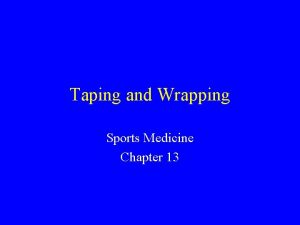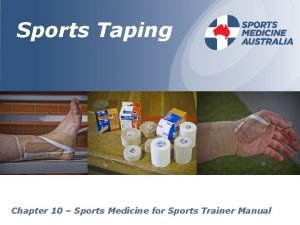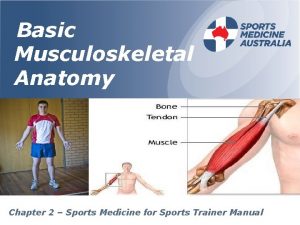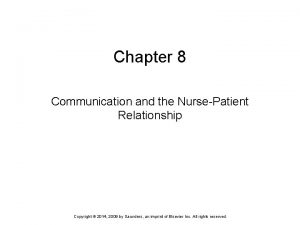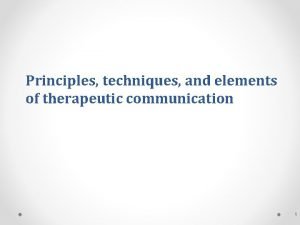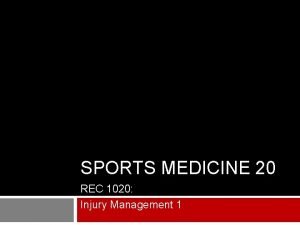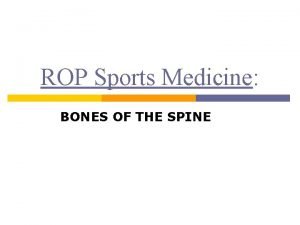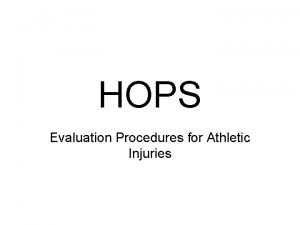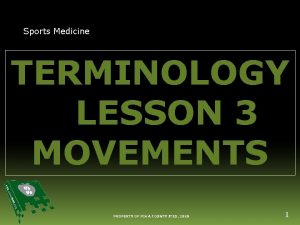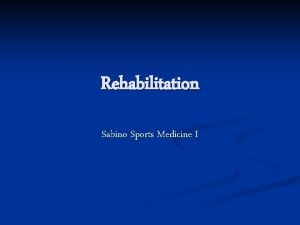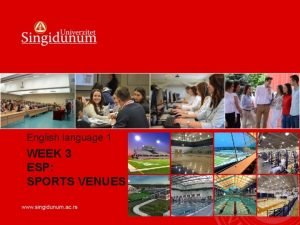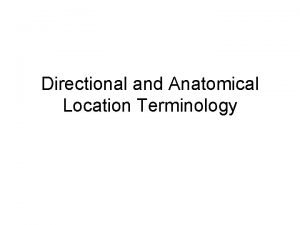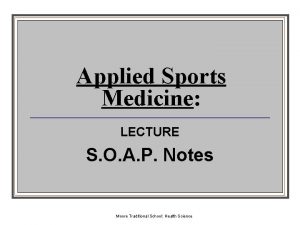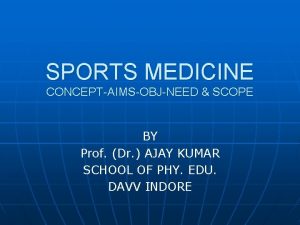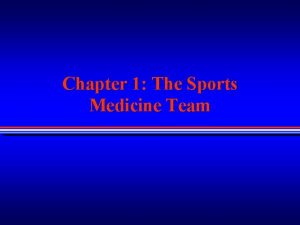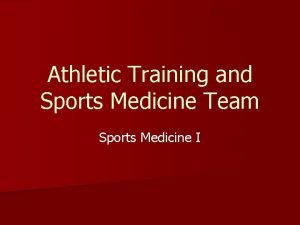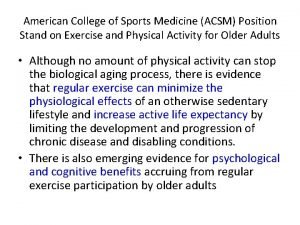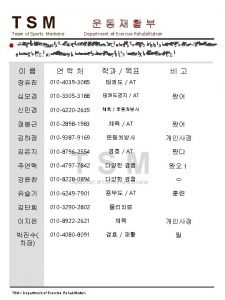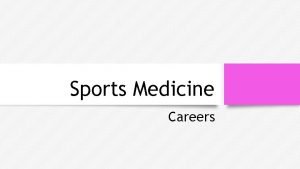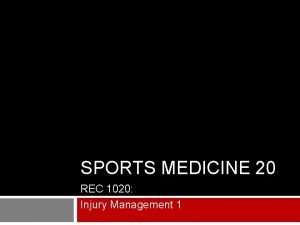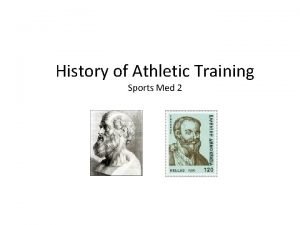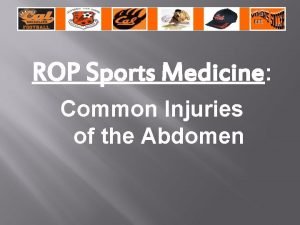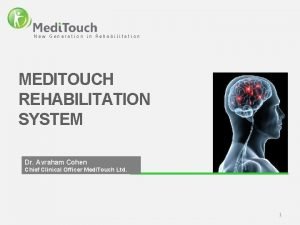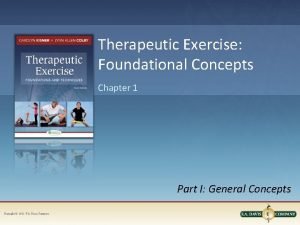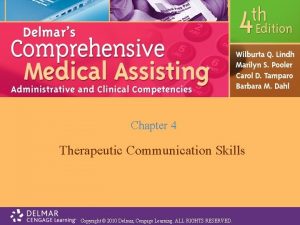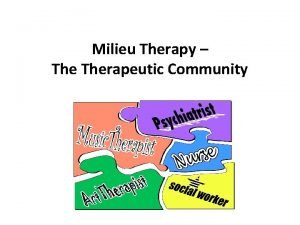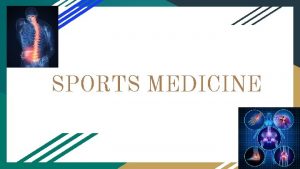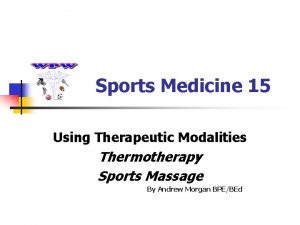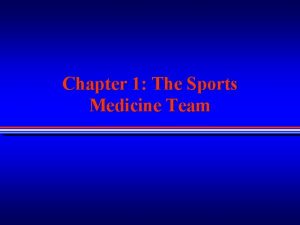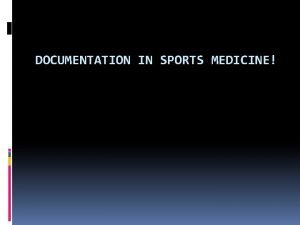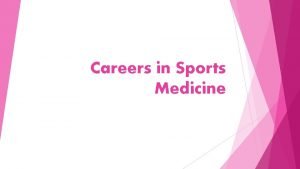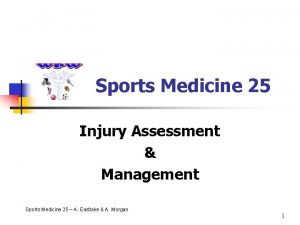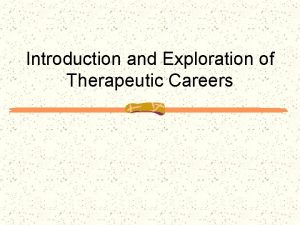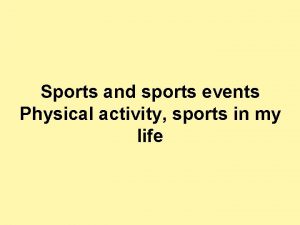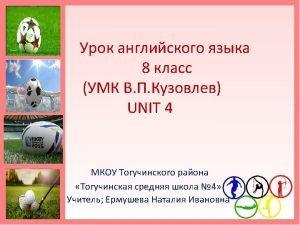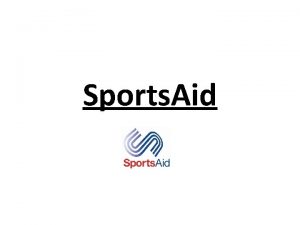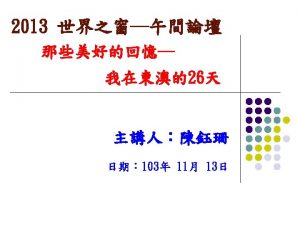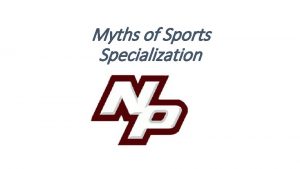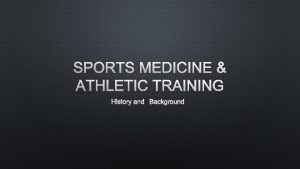Therapeutic techniques and Sports Medicine Chapter 19 The


































- Slides: 34

Therapeutic techniques and Sports Medicine Chapter 19

The Physical Therapy Department • The physical therapy department is made up of trained people who work as a team to assist and direct patients in the rehabilitation process. • Their main goal is to reduce pain, prevent deformity, and promote healing • They also attempt to restore function or assist patients by teaching them new ways to adjust to their disabilities

The Physical Therapy Department • Physical therapy workers may work in the following facilities and agencies: • • Acute care facilities Long-term care facilities Rehabilitation centers Schools that educate disabled persons Public health agencies Home-health care agencies Sports medicine centers Professional or school sports team

Responsibilities of a physical therapy aide • Prepare equipment (hydrotherapy pools) • Assist patients: • • With walking and gait training To dress and undress To position themselves To remove and replace braces, splints, and slings • Change linens on beds and tables • Fold linens • Clean equipment and work area • May inventory materials and supplies

Sports Medicine aide/ athletic trainer • One subspecialty of working as a physical therapy aide is working as a sports medicine aide. • Sports medicine is one of the fastest growing fields in medicine. • It includes working with professional sports teams, high school and college athletes, and individuals with sports-related injuries.

Responsibilities of a sports medicine aide/athletic trainer • Perform all the duties of a physical therapy aide • Prepare equipment(massage tables) • Assist in injury treatments, evaluations, and rehabilitation of athletes • Assist or performs taping, wrapping, protective bracing, and equipment fitting • Help out in pre-practice preparation and post-practice follow-up • Be on hand to assist in event coverage

Massage therapy techniques in sports medicine • Massage therapy plays an important role in sports medicine • Massage is the practice of manipulating the soft tissues of the human body in order to prevent injury or aid in the recovery from injury. • The benefits of massage are an accepted part of many physical rehabilitation programs. • Massage therapy is helpful for several chronic conditions including lower back, arthritis, bursitis, and fatigue. • Massage helps prevent injury and restores mobility to injured muscle tissue.

Preparing patients for therapy • The aide will assist and prepare: • • • The patient Supplies Equipment • There are various types of therapy and each requires a slightly different preparation

Ultraviolet light • -used to treat various diseases, especially those of the skin • It is used to treat the following: • • Acne Pressure sores Psoriasis Wound infections • This treatment can cause severe burning. For this reason, the patient cannot be left unobserved in the room during treatment

diathermy • -the heat inducing treatment that increases the circulation in the treated area • It is often used to treat the following: • • Muscle problems Arthritis Bursitis Tendonitis • Metal attracts heat during this procedure, so it is your responsibility to have the patient remove all jewelry and check to see if they have metal implants, etc

ultrasound • Uses high-frequency sound waves to penetrate deep tissues • It is most commonly used to treat • Pain • Muscle spasms • Problems in circulation • Ultrasound is also used to diagnose specific conditions • Physical therapy only uses ultrasound for therapeutic purposes • This is not suitable for patients with joint implants

thermotherapy • Refers to heat treatments • Heat is used to speed up the healing process • Heat causes the blood vessels to expand • This allows more to circulate to the area • If the area is swollen or inflames the blood helps absorb and carry away the extra fluid

thermotherapy • Is used to: • • Relieve pain Promote muscle relaxation Reduce muscle spasms Reduce inflammation Treat skin ulcers Treat perineal lacerations Reduce swelling Promote drainage • There are two kinds of thermotherapy; moist heat and dry heat

thermotherapy • Moist heat is applied with the following: • • • Hot soaks Hot compresses Hot packs • Dry heat is applied with • • Heat lamps Infrared lights Standard electric bulbs Heating pads

thermotherapy • You need to prepare hot packs so that they are ready when needed • Always check the skin for signs of extreme redness or burning • If a patient complains of discomfort, remove the packs immediately

cryotherapy • Cold therapy causes the blood vessels to get smaller • This slows the flow of blood to the area • This reduces the amount of fluid and helps reduce pain • Cold application is used to: • • • Relieve pain Reduce body temperature Control bleeding Reduce inflammation Prevent edema

cryotherapy • Cryotherapy can be given in two ways: dry cold or moist cold • Dry cold includes the use of: • Ice bags • Ice collars • Moist cold includes the use of: • • • Cold compresses Cold packs Ice massage

cryotherapy • Prepare cold packs so they are ready when needed • Always check the skin for signs of whiteness or bluishness. • If these occur, stop treatment immediately

Hydrotherapy • Water therapy • Hydrotherapy is usually given in a whirlpool • The whole body may be treated or just a limb • This treatment is used to: • • Apply soothing medication Promote relaxation Improve circulation and mobility of an injured limb Loosen and remove dead skin

Hydrotherapy • This treatment is accomplished in various-sized tubs ranging from small basins to a swimming pool. • Your responsibility is to: • Assist the patient in disrobing or exposing the area to be treated • Ensure that the water temperature is correct • Secure the patient to ensure there is no danger or injury • Disinfect and clean the equipment • Assist the patient when large areas of the body are to be submerged • Clean the tub after each treatment

Range of motion • Range-of motion(ROM) exercises are very important for the resident who has limited movement. • ROM exercises are given to: • Stimulate circulation to decrease chance of blood clots or decubitus ulcers • Prevent contractures (permanent contraction of the muscle) • Prevent mineral loss • Prevent other problems such as poor appetite, constipation, respiratory problems, hypostatic pneumonia

Range of motion • Residents are encouraged to move each joint to the best of their ability • This is called active ROM • When you do passive ROM for your residents, you move the joints for them.

Antiembolism Hose • Are used to prevent blood from pooling in the legs • This reduces the possibility of developing phlebitis and blood clots • Elasticized hose are called TEDS or antiembolism hose • These extend from the ankle or foot to calf or midthigh • They are applied after surgery when there is danger of a clot forming and causing thrombophlebitis

Guarding techniques • Use guarding techniques when moving patients from place to place • These techniques protect the patient while transferring a patient from the bed to a gurney or chair, chair to toilet and back again • You use a variety of techniques to transfer the patient: • Pivot technique • Sliding technique • Lifting technique

Guarding techniques • You also use guarding techniques when the patient is ambulating • All patients who can support themselves are encouraged to walk alone or with assistance of another person • You may need to use: • • A guarding belt Use two people to assist Allow patients to hold onto you Use a handrail

exercising • Physical therapy department personnel work with patients to maintain normal functions of all parts of the body • This is accomplished by: • Active ROM • Passive ROM

Rehabilitation Equipment • Ambulation devices assist patients to walk • Canes- provide a third base of support for patients who are slightly unstable on their feet • Use a cane when patients are: • Slightly weaker on one side • Easily thrown off balance • Insecure walking alone

crutches • Provide support and stability by promoting use of hands and arms more than the legs • Use them when patients are able to bear weight: • On one foot or leg • Only partially on one leg or on both feet and legs

walkers • Provide support and stability • Use them when patients are: • Relearning to walk • On limited weight-bearing • Unstable on their feet • To use a walker, the patient must be able to use their hands and arms to adapt properly • Braces- provide specific support for weakened muscle joints or immobilize an injured joint

prosthesis • An artificial body part or an aid to a part of the body that minimizes a disability • The device must be: • Padded • Have good straps • Clean and overall appearance

Transporting devices • Include equipment to move patients from one place to another • The most common type are wheelchairs and gurneys • These make it easy for patients to move who are unable to walk

Adaptive- Assistive Devices • Include equipment that helps a person perform daily activities • These devices range from special holders for silverware to devices that help people put on socks or button clothing

Oxygen therapy • Some residents require oxygen to help them breathe • Concentrated oxygen help these residents breathe more easily • The following are common ways to give oxygen therapy: • Nasal cannula • mask

Oxygen therapy • You have a specific responsibilities for a resident on oxygen therapy: • Ensure all oxygen rules are followed • Check the face and behind the ears to see if the strap is chafing the skin or irritation • Cleaning the oxygen mask or cannula • Provide oral hygiene • Keep tubing free of kinks or blockage • Checking flow rate and oxygen humidifier frequently • Immediately report to supervisor any changes
 Wrist taping athletic training
Wrist taping athletic training Chapter 10 worksheet wrapping and taping techniques
Chapter 10 worksheet wrapping and taping techniques Chapter 2 sports medicine
Chapter 2 sports medicine Perbedaan komunikasi terapeutik dan non terapeutik
Perbedaan komunikasi terapeutik dan non terapeutik Pre-hospital communication
Pre-hospital communication Chapter 8 health team communication
Chapter 8 health team communication What are the principles of therapeutic communication
What are the principles of therapeutic communication Indoor outdoor sports
Indoor outdoor sports Orec-1020
Orec-1020 Rop sports medicine
Rop sports medicine Hops injury assessment
Hops injury assessment Hops in sports medicine
Hops in sports medicine Sports medicine definition
Sports medicine definition Sports medicine terminology
Sports medicine terminology Meditouch sports medicine
Meditouch sports medicine Esp sports medicine
Esp sports medicine Superior vs inferior
Superior vs inferior Soap sports med
Soap sports med Scope of sports medicine
Scope of sports medicine Sports medicine team project
Sports medicine team project Sports med umbrella
Sports med umbrella Acsm position stand
Acsm position stand Sports medicine team definition
Sports medicine team definition Sports medicine careers
Sports medicine careers Objective of sports medicine
Objective of sports medicine Herodicus of megara
Herodicus of megara Rop sports medicine
Rop sports medicine Meditouch sports medicine
Meditouch sports medicine Therapeutic exercise chapter 1 mcqs
Therapeutic exercise chapter 1 mcqs Chapter 4 therapeutic communication skills
Chapter 4 therapeutic communication skills Multicultural therapeutic communication skills
Multicultural therapeutic communication skills Milieu therapy involves
Milieu therapy involves 7 rights of medication administration in order
7 rights of medication administration in order Association for applied and therapeutic humor
Association for applied and therapeutic humor Fonctions techniques et solutions techniques
Fonctions techniques et solutions techniques
